For the first time this season, Notre Dame dominated an opponent in virtually every category of advanced stats. The Irish were perfect in the red zone leaning on a spread run game, and had the 3rd highest efficiency advantage of any P5 vs P5 game last week. Before garbage time Notre Dame out-gained Wake Forest by +4.17 yards per play – a better margin than any mark this season or in 2017.
The Basics

It took a little bit later than anticipated, but let’s all welcome back the return of garbage time! Pinpointing exactly when it starts is always more art than science, but in this case it felt like an inflection point when the Irish scored in the 3rd quarter to go up 42-13. This is consistent with how S&P+ is currently viewing garbage time, so that’s also handy.
It’s worth noting Bill Connelly has recently tightened his criteria for garbage time based on evidence of when teams are actually changing strategy to run out clock. All first quarters are always in, he’s now defining garbage time as up 36+ in the 2nd quarter, 26+ in the 3rd, and 20+ in the 4th. Usually having watched a full game you can when games have shifted, so occasionally my subjective view will differ from S&P+, which isn’t watching the games, but these feel like a solid starting point.
For this contest, it means 27% of plays were run in garbage time. Worth noting is that up to this point the Demon Deacons averaged 3.65 yards per play on offense while the game was competitive, and then piled up 157 yards on 6.04 YPP in garbage time. I would add a note about why total yardage is garbage here, but this week’s Rakes Report (which you should be subscribed to / have read already) put it better than I could:
“After school special lesson: If you’re talking to or reading commentary from someone who is citing Total Defense as a stat in the Year of Our Lord 2018 please remove yourself from the conversation and call the local authorities. Wake Forest racked up nearly 400 yards of offense, 27 first downs and won time of possession because they ran 92 plays. Notre Dame allowed 4.3 yards per Wake Forest snap, which would have ranked third at the end of the 2017 season, behind only Alabama and Clemson. And in regards to time of possession, Wake Forest won that because the Irish had touchdown drives that took 10, 42, 67, 133 and 145 seconds. Do you want Notre Dame to score more slowly?! So, please pay attention to S&P+, FEI or yards per play and please just say no to total yardage and in a lot of cases time of possession and scoring defense.”
Efficiency
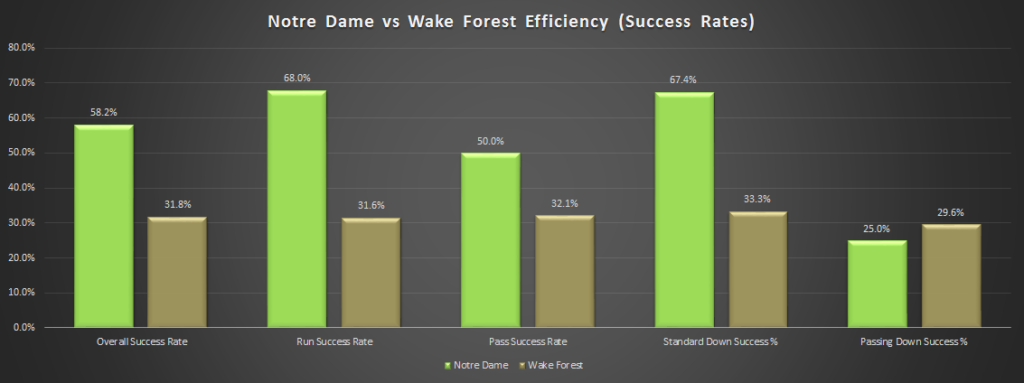
This was a dominant effort by the Irish, with one of the five best efficiency advantages of any game last weekend (a top 3 performance if you want to throw out P5 vs G5 games like Miami-FIU and Ohio State-Tulane). It was a balanced effort in Ian Book’s first start of 2018 – a 50% passing success rate equaled Brandon Wimbush’s best effort as a starter (at Michigan State last season). But a 68% run success rate jumps out as particularly outstanding, with evidence mounting that Ball State was an awful aberration. The running game and offensive line are probably at least good, and trending in the right direction moving into a critical stretch.
Key to this dominance in efficiency was incredible success on standard downs. Move the ball well on two-thirds of your plays and suddenly sustaining drives becomes less of a challenge. The Irish faced just 12 passing downs in 55 non-garbage offensive snaps, avoiding putting Book and the offense too far behind the chains. Passing down success was a bit below average, but can be chalked up to a small sample and a few “failures” by a tough success rate definition that were still productive plays (a 6 yard gain on 3rd and 7 that was converted on 4th down, and an 8 yard run on 2nd and 14).

The defense was excellent as well, unfazed by Wake Forest’s tempo in the heat. Clark Lea’s defense contained All-American hopeful Greg Dortsch to six catches for 56 yards, hit and harassed QB Sam Hartman until he left with an injury, and lived in the Demon Deacon’s backfield. The Irish secondary had been leading the way in terms of causing havoc, causing tons of deflections per game. But on Saturday it was the front seven leading the way, tallying ten tackles for a loss while the Irish defensive backs had just on pass deflection (and one beautiful Troy Pride pick).
As expected,the transition from Wimbush to Book resulted in a far different run-pass mix, especially on first down. After rushing on nearly 80% of first downs against Vanderbilt, the Irish threw on 55% of first down plays before garbage time with Book in. This balance worked beautifully – the Irish averaged nearly identical figures per pass attempt (7.8 yards, including sacks) and per rush (7.84 yards).
Explosiveness
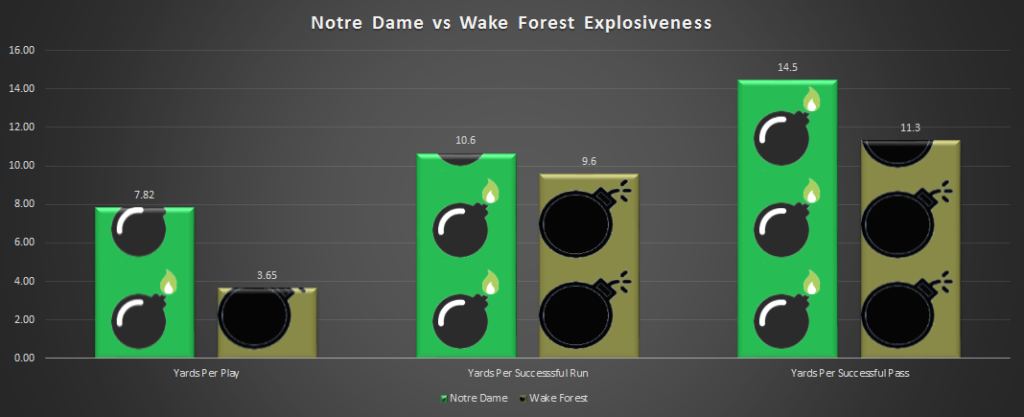
The Irish were +4.17 yards per play before garbage time, an outstanding figure that was higher than any effort this season or in 2017 (with a high mark of +4.0 vs Temple). Interestingly enough, Notre Dame wasn’t all that much more explosive than the Demon Deacons on their successful plays. They just had a whole lot more of them, and were much more effective stringing them together.
The Michael Young screen that nearly went for a long touchdown was emblematic of what the Irish can be with Book at the helm. If the ND offense can be that efficient, eventually some explosive plays are bound to break through. Book’s passing accuracy gives the Notre Dame offense that chance – as friend of the site Jamie Uyeyama noted in this excellent thread, new areas of the passing game were unlocked.
Some stats of interest from #NotreDame-Wake Forest: Ian Book was 10 of 10 for 135 yards on balls caught behind the line of scrimmage. Those are throws that Wimbush had struggled with
— Jamie Uyeyama (@jamieuyeyama) September 24, 2018
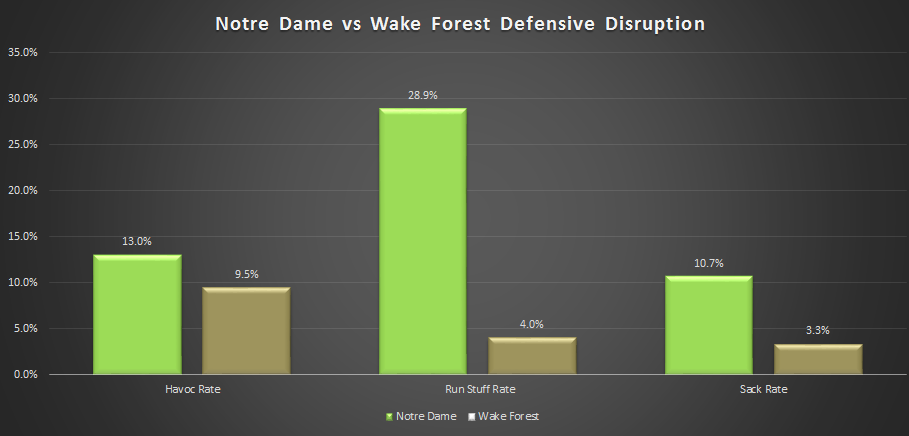
The Irish defense was incredibly disruptive against a true freshman quarterback and vulnerable Wake Forest offensive line. Stuffing nearly 30% of the Demon Deacon’s runs was exceptional, and Notre Dame landed three sacks and constantly pressured Hartman. Most Irish fans had been waiting for some sacks to come through after four weeks of constant pressure from the defensive line, and in Winston Salem the floodgates didn’t exactly break open but came close. Even prior to the game, a closer look via film analysis at Pro Football Focus revealed a pass rush that was extremely effective even if it wasn’t piling up the sacks (yet).
Interesting breakdown – per PFF, Notre Dame is tied for 8th nationally in pass-rush win %, with 13 pressures each for Khaled Kareem and Julian Okwara, tied for 15th among individual edge defendershttps://t.co/X6l6eakZwY
— Michael Bryan (@michaelbryanMB) September 21, 2018
Finishing Drives, Field Position, & Turnovers
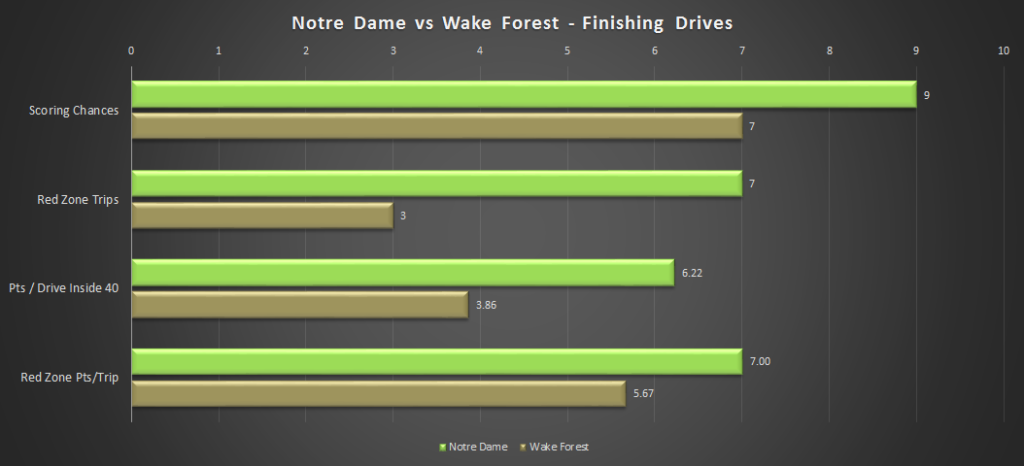
Through the first few drives of the game, it didn’t feel like a new offense. The Irish began with a punt, failed fourth down conversion on a Chris Finke drop, and Michael Young fumble. The next nine Notre Dame drives resulted in eight touchdowns.
Last week I was critical of the Notre Dame red zone offense, in particular bringing in Ian Book with four tight end jumbo sets. There was a lot of data to suggest that even if subbing out Wimbush for Book wasn’t a meaningful downgrade, running the ball out of those sets was far less likely to be successful than spreading defenses out with personnel groups featuring 2+ wide receivers. The Irish were a perfect 7-for-7 in converting red zone touchdowns at Wake, including five scores on goal-line runs out of those multiple receiver sets.
The first red zone touchdown to Brock Wright came on an excellent play-action pass out of the jumbo set on 4th and 1 from the Wake three-yard line. But the other five red zone rushing touchdowns all came out of sets with multiple receivers. Check out the clips below – spreading the defense out allowed the ND offense relatively even numbers in the box when accounting for Book keeping the ball and led to some easy scores.
In this first clip, the Wake linebackers and safeties are slow to react – potentially fearing a play action pass, given Book’s TD on play-action earlier in the half. Despite a missed block by Trevor Ruhland that could have let Tony Jones stroll in untouched, Jones still breaks a tackle for the score.
Again, the Irish spread it out with three receivers from the two. Multiple Wake defenders are sucked in by the fake to Avery Davis, and two corners on the field side of the play are way too far away to make a potential tackle. Book scores the first of three rushing touchdowns and no one touches him.
Overall, this was an excellent game by Chip Long, and quietly the decision-making from Long and Brian Kelly has been excellently aggressive this entire season. Early in the game the Irish didn’t hesitate to go for it on 4th and 8 from the Wake Forest 33, and later didn’t settle for a field goal on 4th and 1 from the 3 and were rewarded with a touchdown. You can quibble with some small play calls, but generally the decisions have been spot-on, and lots of coaches (cough, Harbaugh) have played more tentative in similar situations.
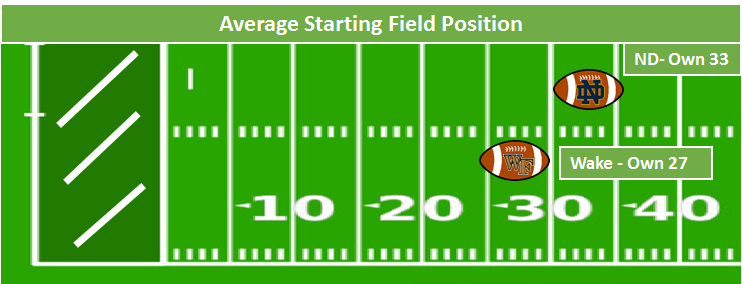
The Irish won the field position battle was well with a pretty complete effort. Special teams were solid, highlighted by a fantastic Finke punt return that almost went for a score. The average Notre Dame possession pre-garbage time gained 44 yards, compared to 24 for Wake Forest. That advantage builds up to a solid field position edge over time, and negated the Young fumble that gave the Deacs an immediate red zone possession.
Speaking of turnovers, that battle ended in a 1-1 tie. Dave Clawson’s crew recovered the game’s only fumble, and Troy Pride’s pick was the beginning of the end of competitive time. Again, Book’s accuracy was on full display on Saturday, with just four passes defensed in 34 pass attempts.
A Peek at Stanford
The Cardinal are a fascinating matchup – a team that has extreme advanced stats ratings (good and bad) across several categories. We’ll have plenty of awesome preview content throughout the week, but a few things stand out looking at Stanford’s advanced stats.
#1 They’re terribly inefficient. Again.
Last year Stanford finished 94th in FBS in offensive success rate. It still worked out to a top-30 offense, because Bryce Love was otherworldly, carrying the Cardinal to the most explosive rushing attack (by IsoPPP) and 7th in overall explosiveness. Late in the year KJ Costello and the usual cadre of overgrown receivers provided enough of a long pass threat to balance things out a bit.
The operating assumption was that a team this talented would have to more efficient in 2018, and ….nope. They’re 110th through four games this year, and somehow 113th in rushing marginal efficiency. It could be defenses focusing all their efforts on Love, because the passing marginal efficiency is 25th. But Love hasn’t really broken out – he’s averaging 6.83 highlight yards per opportunity, almost half the insane 12.7 yards per opportunity he posted last fall.
What this results in is an incredibly streaky offense. Love and the passing game offer an incredibly high upside, but when they go through efficiency droughts, this translates into three and outs. After kicking a field goal to go up 17-3 versus USC, the Cardinal turtled and punted their last five possessions, with no drive longer than 5 plays! At Oregon last week the dry spell came early, with four punts in the first five possessions. Then the last six drives went TD, TD, turnover on downs, TD, FG, TD, and this game remained a top-10 matchup.
#2 They’ve been strong in the red zone and gotten their hands on a lot of passes
Much like Notre Dame, currently fielding a top-10 defense in points per scoring opportunity allowed, Stanford’s defense has excelled as the field shortens. At just 2.7 yards per trip inside the opponent 40, the Cardinal actually lead the country in the category. David Shaw’s defense has been pretty mediocre in opponent efficiency (54th in defensive success rate) and allowing big plays (52nd in opponent IsoPPP), but made big plays in the right parts of the field. They’ve also benefitted from top-25 starting field position, another category where the team was excellent in 2017.
Also in common with the Irish defense is the ability for the Stanford secondary to get their hands on passes. At 8.25 pass break-ups per game, Stanford is 3rd nationally (ND is 12th at 6.5 per game). They’ve been led by sophomore and one-time Notre Dame commit Paulson Adebo, who is tied for 1st nationally with 11 PBU’s (Julian Love is tied for 3rd with 9). There will be some contested passes in this game, and some deflections up in the air or in the right direction will likely have significant implications. Avoiding putting the ball in tight windows as much as possible will be key for both quarterbacks.
#3 Stanford will play slow, and challenge Notre Dame’s linebackers
The Cardinal are on the opposite side of the spectrum of Wake Forest, with the 130th pace. Costello will take time, survey the defense, and look for mismatches. Watching his highlights against Oregon, a few things jump out. Costello targeted Bryce Love on several occasions when he was matched up on a linebacker, and fit several passes through the Ducks zone over linebackers heads.
There was notably not a lot of play-action, but that may be something the Cardinal look to exploit this weekend. Of Notre Dame’s relative weaknesses, the play-action pass has been one early – Kyle Shurmur and Vanderbilt were able to exploit it frequently in the second half of that game.
Some notes on the #NotreDame defense after going back and examining the Vandy game. Not a great day for the Irish vs play-action. Kyle Shurmur was 8 of 10 for 151 yards https://t.co/WjRWMjAD13
— Jamie Uyeyama (@jamieuyeyama) September 17, 2018
Last year, the ND defense was able to pressure Costello pretty well, but he moved well in the pocket and made some clutch throws with defenders in his face. Maybe this year’s line, which appears improved, can convert some of those opportunities into sacks, fumbles, or deflections.

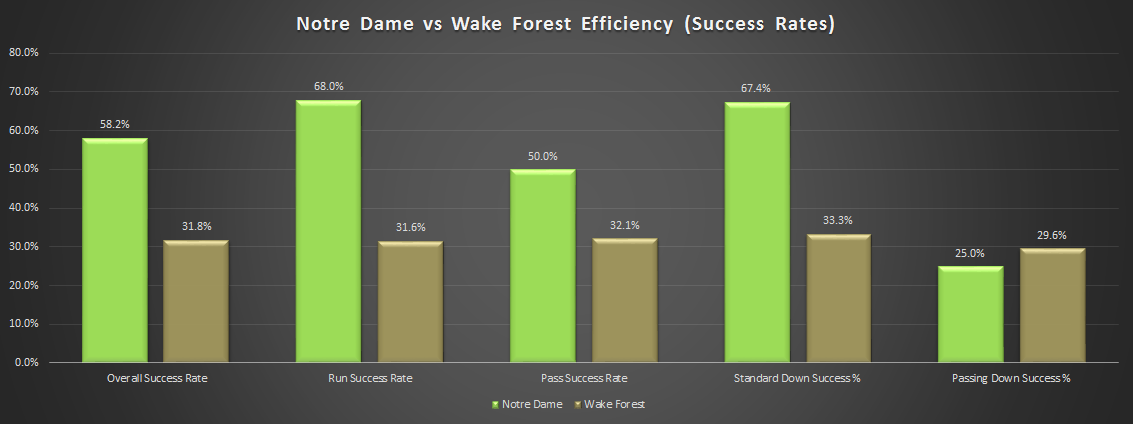



I thought the S&P+ would be even a little more happy with the #Heismanuscript offense than it ended up being. Still, better than 50% to finish 11-1 or better is a pretty cool place to be after week 4.
I love this chart. Thanks for posting every week. I’m still just rooting for back to back 10 win seasons, so this makes me very optimistic about that!
I think our offense has tended to the streaky side as well. Even the Wake game would qualify at that.
The teams are pretty evenly matched, and I would expect a tight game. Unlike many games against top teams under Kelly, I think the odds of an ND blow-out or a Stanford blow-out are about the same. Normally, I feel there is a greater probability of a top opponent blowing us out, and I think the results bear that out.
Barring losing the turnover battle by more than 1, I think ND wins this game by a TD. Something like 31-24 or 24-17. The trees play slow so probably the latter.
I was at the Wake game, and was surprised by the one stat of their running more plays than we did. I had the impression we were playing as fast as they were. They probably would have gotten well over 110 plays, but the entire 4th quarter they were in place early, but not snapping the ball until the play clock had run way down. There is probably not an easy way to figure it out, but I would be curious if that was correct or it was just that we were playing faster than we normally do (if we were). I imagine there is no reported stat about when on the playclock the ball is snapped.
Any low-efficiency offense is going to be really inconsistent, and we definitely were that way prior to Wake, and could still be moving forward. Over 4 points per drive is a pretty great number though, so not sure that qualifies (even though the distribution of scoring drives/not trended toward multiple in a row). It’s actually kind of a incredible that Stanford has the explosiveness to be this streaky two years in a row, most programs with that low of success rate would just be bad offenses.
The ND offense is currently running at the 12th highest adjusted tempo, so you are correct that the pace wasn’t that huge of a difference. Part of the disparity in plays run was just randomness with short ND drives – a two-play drive with a fumble, two-play drive after Finke returned the punt to the doorstep, a 4-play TD drive with the long pass to Young, a 3-play TD drive after the Pride pick.
I don’t think anyone tracks it via time on playclock but have seen stats tweeted using plays per second (just taking time of possession/ plays run). Maybe someone has a source on that?
Loves me some advanced stats. Funny thing is that TV announcers still talk about total yardage, total offense and defense, etc. I guess they feel the people are too dumb for advanced stats?
There’s definitely slow movement towards using more per play and efficiency metrics. And I do think total yardage makes the most sense in the TV context of a game, because there the “per play” metrics matter a bit less. We’re still draw in by “wow a 300 yard passing day” even if it takes 50 pass attempts to get there.
What is dumb is when you see total yardage (or even yards per game) used instead of per play numbers to rank teams. For example, right now ND has given up the 85th most total passing yards yet we are tied (with Bama, interestingly enough) for 15th in yards per attempt. Some idiot previewing this game will mentioned the former instead of the latter.
The other thing I wish everyone would just migrate over to is counting sack yardage against passing totals rather than rushes. It makes rushing numbers distorted, especially trying to tell how strong a runner a QB is, and it makes no sense.
The NFL has been taking sack yardage out of passing for as long as I can remember. And they don’t get anything right. But some lazy official stat keeper hasn’t figured out to change this for the NCAA.